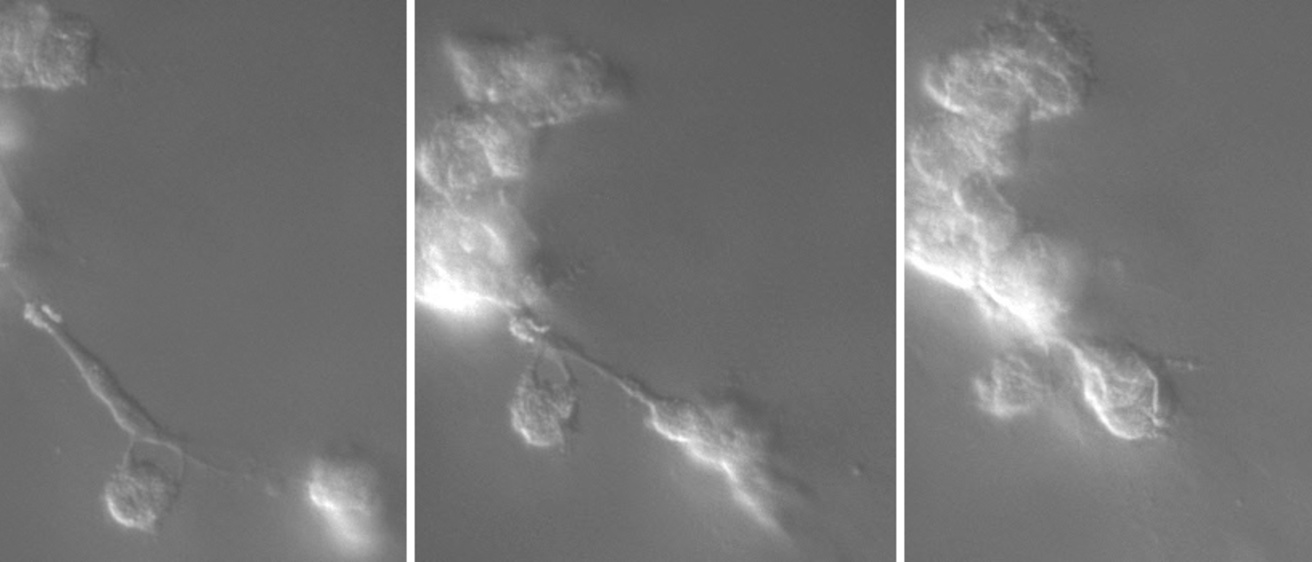There’s a reason why melanoma, the most serious type of skin cancer, is so aggressive. You just need to watch the cells in action.
Researchers at the University of Iowa did just that, documenting in real time and in 3-D how melanoma cells form tumors (See videos). The cells waste no time finding their cancerous cousins, slashing their way through a lab-prepared gel to quickly join other melanoma cells and form tumors.
The findings were published online in the journal PLOS One.
Biology professor David Soll and his team used unique computer-assisted 3-D reconstruction software to chronicle how both breast tissue cancer cells and melanoma cells form tumors. The group found the two cancers act similarly in the joining stages of tumor formation. With that knowledge, they screened more than four dozen monoclonal antibodies—unique agents that can stop cells from growing or forming tumors and can be mass produced—before finding two that block tumor creation in both types of cancer.
“It upholds our hypothesis that coalescence is so similar that there’s got to be the same molecules and mechanisms that do it, and we may be able to find a drug that shuts tumor formation down without being toxic to healthy cells in the body,” says Soll, the paper’s corresponding author.
Soll’s team, in a paper published in PLOS One in March 2015, previously showed that human breast cancer cells form tumors by extending cables—bridges of sorts—between small aggregates of cancer cells. In the current study, the group reports that melanoma cells behave in a similar way, but with variations in timing and speed.
For one, melanoma cells are on the go immediately and at all times; they appear to both divide into more cells and rush to join clusters simultaneously.
One lab test showed a single cell moving a distance three times its diameter and joining with a small cancerous cluster in just four hours. In another instance, within 72 hours, 24 individual melanoma cells or small clusters of cells had mostly repositioned themselves into one large cancerous clot—an 80 percent accretion rate.
Melanoma cells are “fast as lightning,” says Soll, Roy J. and Lucille Carver/Emil Witschi Professor in the College of Liberal Arts and Sciences. “They don’t sit still. They’ve got ants in their pants.”
Breast cancer cells, in contrast, are more ponderous and lumbering in both their movements and in forming tumors. In the previous paper in PLOS One, Soll’s group found breast cancer cells wait on average 100 hours—dividing into more cells during much of that interval—before forming “clonal islands,” or small clusters that then gradually join to form large tumors.
The reason why melanoma cells seem to always be on the move could lie in their evolutionary origin, Soll says. Melanocytes, healthy skin cells that form the pigment melanin, come from neural crest cells, which are created in the spinal column. Once programmed, melanocytes migrate through the tissue to take their place in the upper layer of the skin.
“They’re professional crawlers,” Soll says. “They were born to move.”
Because melanoma cells are derived from melanocytes, it stands to reason that melanoma cells would retain the same mobile profile. Soll’s lab tests appear to show that is the case.
Still, how melanoma cells join into tumors—whether by individual cells coming together or small or large clusters of cells doing so—follows the same pattern as breast tissue cancer cells: Cables are extended to reel in other cells or clusters.
That was an interesting revelation to Soll, who then screened 51 monoclonal antibodies before finding two, anti-beta 1 integrin/(CD29) and anti-CD44, that blocked tumor creation in both cancers.
“What’s so cool is the same drug that stops breast cancer cells from undergoing coalescence also stops melanoma cells from undergoing coalescence, despite these cancers’ whole history being different,” Soll says. “That means there’s a commonality despite the different origins. And that also means there might be a magic bullet (to stop tumor formation) for all cancers.”
The paper, “Melanoma Cells Undergo Aggressive Coalescence in a 3D Matrigel Model That Is Repressed By Anti-CD44,” was published online on March 6.
The research was funded by the Monoclonal Antibody Research Institute and the Developmental Studies Hybridoma Bank, the latter a national resource created by the National Institutes of Health housed at the UI.
Deborah Wessels and Daniel Lusche, both in the UI’s biology department, are the paper’s co-first authors. Contributing authors include Edward Voss, Spencer Kuhl, Emma Buchele, Michael Klemme, Kanoe Russell, Joseph Ambrose, and Benjamin Soll, all from the UI’s biology department. Aaron Bossler, from the UI’s Department of Molecular Pathology; Mohammed Milhem in the UI’s Department of Internal Medicine; and Charles Goldman, with Mercy Hospital System of Des Moines, Iowa, also contributed to the research.
